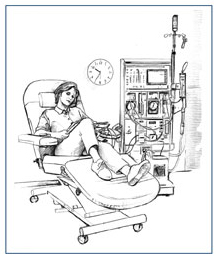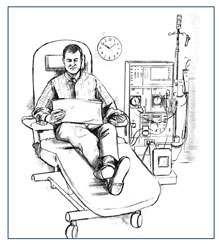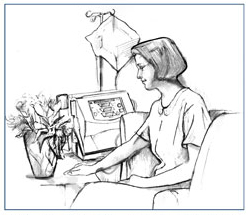

Home Hemodialysis
On this page:
Hemodialysis (HD) is a life-preserving treatment for hundreds of thousands of Americans with kidney failure. But the standard schedule of in-center HD three times a week is, at best, inconvenient, and at worst, hard on the heart.
People who receive in-center HD travel to the clinic three times a week and sit in a chair for 3 to 4 hours each time while their blood is cleaned. Waiting for needle sites to stop bleeding and blood pressure to return to normal takes even more time. In-center HD patients must follow a strict schedule because the clinic treats three to five shifts of patients in the course of the day. Someone who gets to the clinic late often can’t make up the time by staying longer because the machine is needed for the next patient.
Between treatments, in-center HD patients must limit drinking fluids to avoid gaining too much weight and raising their blood pressure. The standard HD diet also restricts phosphorus, salt, and potassium. The patient may have to take several drugs to control blood pressure and other problems like anemia and high phosphorus levels. Many people who dialyze three times a week complain of feeling exhausted or “washed out” for a few hours after a session. In the course of a week, the HD patient may feel highs and lows as the body builds up fluid and wastes and then has them washed away during treatments.
 
A dialysis clinic must follow a strict schedule to make room for several shifts of patients each day.
In recent years, many people have found that doing HD at home has many benefits. New dialysis machines are smaller and easier to use, making home HD more practical. Some machines may require special wiring or plumbing changes in the home, but others use standard household outlets. The home must have room for the HD machine, supplies, and in some cases a water purification machine.
How does home HD work?
A small but growing number of clinics offer home HD in addition to standard HD treatments.
The patient starts learning to do treatments at the clinic, working with a dialysis nurse. Most people who do home HD have helpers who train with them at the clinic. The helper can be a family member, neighbor, or close friend. Some programs do not require a helper if the patient can do all the tasks alone.

New machines for home hemodialysis are smaller and easier to use.
The clinic will provide a machine for use in the home or help the patient get a machine from a supplier. The patient does not have to buy the machine. Supplies, such as dialysis solution, will be delivered to the home once or twice a month.
During training, the patient learns to
- prepare equipment and supplies
- place the needle in the vascular access
- monitor the machine
- check blood pressure and pulse
- keep records of the treatments
- clean the equipment and the room where dialysis is done
- order supplies
Training often takes 3 to 8 weeks. The training staff makes sure the patient is confident about performing each task before doing home HD. Someone from the clinic will be available to answer phone calls 24 hours a day. Some programs also monitor treatments over the Internet.
The patient returns to the clinic once a month to see the nephrologist, dialysis nurse, and dietitian. A blood sample will be tested to ensure the HD treatments are working and to detect any problems, such as anemia or high potassium levels, that should be treated.
[Top]
What are the risks of home HD?
Home HD has the same risks for complications that exist with in-center HD, including low blood pressure and infection. The most serious risk is the possibility of an air embolism—a condition in which air is introduced into the blood stream accidentally, preventing the heart from adequately pumping blood. Another serious risk is blood loss if a catheter separates. Home HD patients and their helpers learn to watch for these problems and are trained to act quickly if they arise.
[Top]
What are the advantages of home HD?
Home HD lets the patient set the schedule. The patient can choose treatment times to fit other activities, such as going to work or caring for a family member.
The patient can dialyze more often at home. People who dialyze at a clinic skip 4 days each week, so wastes and fluid build up in their bodies. Dialyzing at home five to seven times per week means wastes and fluid don’t build up as much in the body. Muscle cramps that are common in people using the standard HD may be less common in those who choose home HD because wastes and fluid are cleared more often.
Treatment plans usually follow one of two schedules:
Short daily treatments—Some people dialyze at home during the day. Because they do it every day—or at least five or six times a week—they do not have to dialyze as long. They can finish in 2 or 3 hours. And they save even more time because they do not have to travel to and from the clinic. Daily treatments keep blood pressure more level than standard HD. Many people who do daily HD no longer need blood pressure pills. Long nightly treatments—Some people dialyze at night while they sleep. Then they have the whole day free for other activities. The longer time of nightly HD allows for a slower blood flow rate. This gentle treatment is easy on the patient’s access and heart. Because the treatments are so long, they remove more phosphorus and other wastes than short treatments can. Many people who do nightly HD no longer need blood pressure pills or phosphate binders. Nightly HD is done from 3 to 6 nights per week.
The schedule can be tailored to fit each person’s needs.
Because use of home HD is still increasing, researchers have not been able to do large studies that compare home treatment with standard HD. But dozens of small studies have found better results in patients who do daily or nightly home HD. Reported benefits include
- better blood pressure control with fewer drugs
- better control of phosphate levels in the blood
- less limited diet and fluids than standard HD
- reversal of some heart damage caused by high blood pressure
People who do home HD say it improves their quality of life. Those who have switched from standard to more frequent home HD say they have more energy, feel less nauseous, and sleep better. Many say they value the control they gain by doing their own treatments.
[Top]
What are some barriers to home HD?
Although growing, the number of clinics that offer home HD is limited. Some patients may find that the nearest home HD clinic is an hour or two away. See the Home Dialysis Central website at www.homedialysis.org to find clinics that train people to do home HD.
Insurers that pay for HD treatments, including Medicare, have set payment based on the standard schedule of three treatments a week. Clinics may limit daily HD to those who have employer group health plans because payment from Medicare alone would not cover their costs. Medicare rules state, “Claims for hemodialysis furnished more frequently than three times per week must be accompanied with medical documentation explaining the reasons for the additional dialysis sessions” (Medicare Provider Reimbursement Manual, Part 1, Chapter 27 § 2709). A doctor may need to write a letter saying that daily HD will help the patient have better outcomes. Patients should talk with their insurance provider or clinic social worker about whether payments for daily home HD will be covered. Nightly home HD can be done three times per week and can be paid for by Medicare alone.
[Top]
Points to Remember
- New, smaller dialysis machines are making home hemodialysis (HD) more practical.
- Training for home HD takes 3 to 8 weeks.
- People doing home HD can choose between shorter daily treatments or longer nightly treatments.
- People who do home HD say it improves their quality of life.
- Patients should talk with their insurance provider or clinic social worker about whether payments for daily home HD will be covered.
[Top]
Hope through Research
The National Institute of Diabetes and Digestive and Kidney Diseases (NIDDK), through its Division of Kidney, Urologic, and Hematologic Diseases, supports the following programs and studies to help improve treatment for people with kidney disease and kidney failure, including
patients on HD:
The End-Stage Renal Disease Program. This program promotes research to reduce medical complications of kidney failure, including bone, blood, nervous system, metabolic, digestive, heart, and hormone problems. The research focuses on improving dialysis equipment and procedures. The program also seeks to increase kidney graft and patient survival and to improve quality of life. The Frequent Hemodialysis Network (FHN). This multicenter clinical trial will test whether HD done more than three times a week has better outcomes than the standard schedule. The FHN is testing two ways to increase the dialysis dose at Clinical Centers in the United States and Canada. The FHN Daily Trial compares standard HD, done for at least 2.5 hours, 3 days per week, with more frequent HD done for 1.5 to 2.75 hours, 6 days per week. The FHN Nocturnal Trial compares standard home HD done 3 days per week with nightly home HD done 6 nights per week. The U.S. Renal Data System (USRDS). This national data system collects, analyzes, and distributes statistics on the use of dialysis and transplant to treat kidney failure in the United States. The USRDS is funded by the NIDDK and the Centers for Medicare & Medicaid Services. The USRDS publishes an Annual Data Report, which covers how many people have kidney failure, how many people get kidney failure each year, survival rates, and trends over time. The report also compiles data on the effects of the different treatment options and shares the findings of special research studies. The Hemodialysis Vascular Access Clinical Trials Consortium. This program is conducting a series of multicenter, randomized, placebo-controlled studies of drug treatments to reduce the failure and complication rate of arteriovenous grafts and fistulas in HD. New drugs to stop blood clots and reduce inflammation are also being tested.
The U.S. Government does not endorse or favor any specific commercial product or company. Trade, proprietary, or company names appearing in this document are used only because they are considered necessary in the context of the information provided. If a product is not mentioned, the omission does not mean or imply that the product is unsatisfactory.
[Top]
For More Information
American Association of Kidney Patients
3505 East Frontage Road, Suite 315
Tampa, FL 33607
Phone: 1–800–749–2257
Fax: 813–636–8122
Email: info@aakp.org
Internet: www.aakp.org
Home Dialysis Central
c/o Medical Education Institute, Inc.
414 D’Onofrio Drive, Suite 200
Madison, WI 53719
Phone: 608–833–8033
Email: lifeoptions@MEIresearch.org
Internet: www.homedialysis.org
National Kidney Foundation
30 East 33rd Street
New York, NY 10016
Phone: 1–800–622–9010 or 212–889–2210
Fax: 212–689–9261
Internet: www.kidney.org
The National Kidney and Urologic Diseases Information Clearinghouse collects resource information about kidney and urologic diseases for the National Institute of Diabetes and Digestive and Kidney Diseases (NIDDK) Reference Collection. This database provides titles, abstracts, and availability information for health information and health education resources. The NIDDK Reference Collection is a service of the National Institutes of Health.
You may view the results of the automatic search on home hemodialysis.
If you wish to perform your own search of the database, you may access and search the NIDDK Reference Collection database online.
This publication may contain information about medications used to treat a health condition. When this publication was prepared, the NIDDK included the most current information available. Occasionally, new information about medication is released. For updates or for questions about any medications, please contact the U.S. Food and Drug Administration at 1–888–INFO–FDA (463–6332), a toll-free call, or visit their website at www.fda.gov. Consult your doctor for more information.
[Top]
About the Kidney Failure Series
The NIDDK Kidney Failure Series includes six booklets and eight fact sheets that can help you learn more about treatment methods for kidney failure, complications of dialysis, financial help for the treatment of kidney failure, and eating right on hemodialysis. For free single printed copies of this series, please contact the National Kidney and Urologic Diseases Information
Clearinghouse.
[Top]
National Kidney and Urologic Diseases Information Clearinghouse
3 Information Way
Bethesda, MD 20892–3580
Phone: 1–800–891–5390
TTY: 1–866–569–1162
Fax: 703–738–4929
Email: nkudic@info.niddk.nih.gov
Internet: www.kidney.niddk.nih.gov
The National Kidney and Urologic Diseases Information Clearinghouse (NKUDIC) is a service of the National Institute of Diabetes and Digestive and Kidney Diseases (NIDDK). The NIDDK is part of the National Institutes of Health of the U.S. Department of Health and Human Services. Established in 1987, the Clearinghouse provides information about diseases of the kidneys and urologic system to people with kidney and urologic disorders and to their families, health care professionals, and the public. The NKUDIC answers inquiries, develops and distributes publications, and works closely with professional and patient organizations and Government agencies to coordinate resources about kidney and urologic diseases.
Publications produced by the Clearinghouse are carefully reviewed by both NIDDK scientists
and outside experts. This fact sheet was reviewed by Dorian Schatell, M.S., Medical Education Institute.
This publication is not copyrighted. The Clearinghouse encourages users of this publication to duplicate and distribute as many copies as desired.
NIH Publication No. 08–6232
February 2008
[Top]
|






